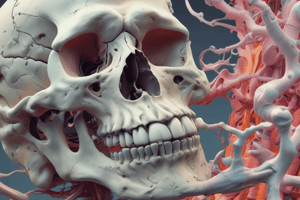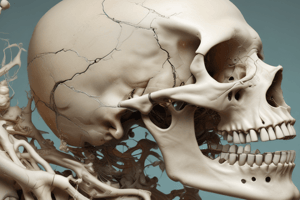Podcast
Questions and Answers
Which layer of bone tissue is primarily responsible for providing strength and structural integrity?
Which layer of bone tissue is primarily responsible for providing strength and structural integrity?
- Compact bone (correct)
- Periosteum
- Spongy bone
- Bone marrow
What is the primary role of osteoclasts in bone remodeling?
What is the primary role of osteoclasts in bone remodeling?
- Maturing into osteocytes
- Breaking down and reabsorbing bone (correct)
- Transporting nutrients to bone cells
- Forming new bone tissue
During which phase of bone healing post-fracture does granulation tissue form?
During which phase of bone healing post-fracture does granulation tissue form?
- Reparative phase
- Reactive phase (correct)
- Latent phase
- Remodeling phase
What is a key consideration during the reactive phase of bone healing?
What is a key consideration during the reactive phase of bone healing?
Which of the following factors can negatively influence bone fracture healing?
Which of the following factors can negatively influence bone fracture healing?
What is a common treatment approach for an undisplaced, unstable fracture?
What is a common treatment approach for an undisplaced, unstable fracture?
What is the main purpose of external fixation in orthopedic surgery?
What is the main purpose of external fixation in orthopedic surgery?
What is a key characteristic of the Ilizarov procedure?
What is a key characteristic of the Ilizarov procedure?
What is the primary purpose of the bone distraction process?
What is the primary purpose of the bone distraction process?
Which method of implant fixation offers a higher stability and allows weight-bearing earlier post-surgery?
Which method of implant fixation offers a higher stability and allows weight-bearing earlier post-surgery?
What is a common reason for patients to undergo arthroplasty?
What is a common reason for patients to undergo arthroplasty?
What is the expected recovery weight-bearing status after a hybrid fixation procedure?
What is the expected recovery weight-bearing status after a hybrid fixation procedure?
Which of the following is a significant risk associated with the posterolateral approach to hip replacement?
Which of the following is a significant risk associated with the posterolateral approach to hip replacement?
What special consideration might be needed for a patient post-arthroplasty regarding dressing?
What special consideration might be needed for a patient post-arthroplasty regarding dressing?
Which muscle group is primarily incised during the posterolateral approach to hip replacement?
Which muscle group is primarily incised during the posterolateral approach to hip replacement?
Which level of weight bearing allows a minimal amount of weight to be placed on the operated leg?
Which level of weight bearing allows a minimal amount of weight to be placed on the operated leg?
In the context of post-operative occupational therapy for hip arthroplasty, what is the PRIMARY focus on Post-Op Day 0 (POD 0)?
In the context of post-operative occupational therapy for hip arthroplasty, what is the PRIMARY focus on Post-Op Day 0 (POD 0)?
An adolescent patient is diagnosed with Slipped Capital Femoral Epiphysis (SCFE). What etiological factor is MOST associated with this condition?
An adolescent patient is diagnosed with Slipped Capital Femoral Epiphysis (SCFE). What etiological factor is MOST associated with this condition?
What is a KEY aspect of the occupational therapist's role when addressing environmental factors for a patient with Slipped Capital Femoral Epiphysis?
What is a KEY aspect of the occupational therapist's role when addressing environmental factors for a patient with Slipped Capital Femoral Epiphysis?
During a knee replacement, how is the patella primarily addressed?
During a knee replacement, how is the patella primarily addressed?
A patient presents with an ankle injury. Which of the following clinical findings is MOST indicative of a potential ankle fracture rather than a sprain?
A patient presents with an ankle injury. Which of the following clinical findings is MOST indicative of a potential ankle fracture rather than a sprain?
According to the Weber classification, a Weber A ankle fracture involves which specific characteristic?
According to the Weber classification, a Weber A ankle fracture involves which specific characteristic?
A Weber C ankle fracture is characterized by:
A Weber C ankle fracture is characterized by:
What is a Pilon fracture?
What is a Pilon fracture?
A Maisonneuve fracture is described as:
A Maisonneuve fracture is described as:
A Tillaux fracture is caused by what MOI? and in which population is its highest incidence observed?
A Tillaux fracture is caused by what MOI? and in which population is its highest incidence observed?
Flashcards
Bone Distraction Rate
Bone Distraction Rate
The process of lengthening bone by 1 mm per day to promote healing.
OT Role in Post-Surgery
OT Role in Post-Surgery
Occupational therapy tasks post-surgery include managing edema, wound care, and promoting ADLs.
Arthroscopy
Arthroscopy
A minimally invasive procedure using cameras for joint investigation or repair.
Total Arthroplasty
Total Arthroplasty
Signup and view all the flashcards
Cemented Implant Fixation
Cemented Implant Fixation
Signup and view all the flashcards
Weight Bearing (NWB)
Weight Bearing (NWB)
Signup and view all the flashcards
Posterolateral Approach
Posterolateral Approach
Signup and view all the flashcards
Hip Precautions
Hip Precautions
Signup and view all the flashcards
Periosteum
Periosteum
Signup and view all the flashcards
Compact Bone
Compact Bone
Signup and view all the flashcards
Spongy Bone
Spongy Bone
Signup and view all the flashcards
Osteoblasts
Osteoblasts
Signup and view all the flashcards
Osteoclasts
Osteoclasts
Signup and view all the flashcards
Bone Healing Phases
Bone Healing Phases
Signup and view all the flashcards
External Fixation
External Fixation
Signup and view all the flashcards
Ilizarov Procedure
Ilizarov Procedure
Signup and view all the flashcards
Pre-op Education
Pre-op Education
Signup and view all the flashcards
POD 0 Activities
POD 0 Activities
Signup and view all the flashcards
POD 1 Focus
POD 1 Focus
Signup and view all the flashcards
POD 3 Independence
POD 3 Independence
Signup and view all the flashcards
Slipped Capital Femoral Epiphysis
Slipped Capital Femoral Epiphysis
Signup and view all the flashcards
Knee Replacement Procedure
Knee Replacement Procedure
Signup and view all the flashcards
Weber Classification A
Weber Classification A
Signup and view all the flashcards
Weber Classification C
Weber Classification C
Signup and view all the flashcards
Pilon Fracture
Pilon Fracture
Signup and view all the flashcards
Tillaux Fracture
Tillaux Fracture
Signup and view all the flashcards
Study Notes
Bone Anatomy
- Periosteum: Outer layer of bone, serving as an attachment point for tendons, ligaments, and nerves.
- Compact bone: Dense, strong, and mineralized outer layer of the bone, providing support and protection.
- Spongy bone: Inner layer of bone, containing bone marrow (fat deposits), keeping the bones light while offering strength. Also contains blood vessels.
- Long bone structure: Comprised of a shaft (diaphysis), and two ends (epiphyses). The diaphysis contains compact bone, while the epiphyses contain spongy bone.
Bone Growth
- Ossification: Begins at 8 weeks after conception. This ongoing process involves the development and formation of bone throughout life.
- Cell types involved:
- Osteoblasts: Bone-forming cells which build new bone tissue.
- Osteocytes: Mature bone cells, maintaining bone tissue.
- Osteoclasts: Bone-resorbing cells which break down existing bone tissue.
- Bone growth is not uniform throughout the body
- Excess bone that is removed to ensure growth is controlled
Common Bone Disorders
- Congenital disorders
- Arthritic disorders : Soft tissue and autoimmune conditions, like inflammation of the bursae (fluid sacs), rheumatoid arthritis, gout and other conditions causing inflammation or damage.
- Osteoporosis: A condition leading to the gradual loss of bone mass, resulting in decreased bone density and increased risk of fractures.
- Degenerative Joint Disease (OA): Common condition causing cartilage damage and inflammation in joints.
- Tumors: Cancers that affect bones.
- Fractures: A break in the bone.
Bone Growth Post-Fracture
- Reactive phase: Inflammation and granulation tissue formation within 2–4 weeks post fracture. Key questions include immobilization needs, blood supply adequacy, and nutrition provision.
- Reparative phase: Osteoblasts and new tissue formation 4 weeks to 8 months after fracture
- Remodelling phase: Bone healing and remodelling 3 to 5 years after fracture, depending on age and health of the individual.
Bone Treatment and Medical Conditions
- Medical Conditions: Affecting bone growth and repair: diabetes, hormone imbalances, vascular diseases, and use of steroids.
- Treatment Options:
- Closed reduction: Aligning bone fragments without surgery
- Open reduction internal fixation (ORIF): Using surgical plates, screws, wires to stabilize the bone.
- External fixation: Using an external frame to stabilize broken bones.
- Implantation: Using implants such as screws, plates, and nails.
- Prostheses: A replacement for a dysfunctional joint or bone.
OT Role
- Pre-Op Assess client's environmental needs(home, school, leisure), safety, equipment, and implement strategies for mobility, self care and dressing, and transfers.
- Post-Op: Provide education & demonstrate mobility, transfers, wound care, and ADLs.
Orthopedic Equipment
- Equipment like long handled reachers, shoehorns, raised toilet seats, grab bars, shower benches, tub transfer benches all help in effective mobility.
Bed Mobility & Bathing Tips
- Bed Mobility: Important to assist the patient in safe transfers, avoid injury by instructing on proper body mechanics for transfers.
- Bathing: Implement proper techniques for bathing, assist in use of necessary equipment to prevent injury/fall, or difficulty performing the task.
Car Transfers
- Instruct on proper car transfer technique, using the appropriate equipment.
Driving & House Work
- Driving: Return to driving as indicated by the physician with safe practices.
- House Work: Assist with light housekeeping, laundry, yard work based on the patient's needs and limitations.
Medical Conditions
- Slipped Capital Femoral Epiphysis (SCFE): A common condition in adolescents where the femoral head slips from its normal position. This occurs during periods of rapid growth, and it is often seen in overweight or obese children. This is typically a unilateral condition.
- Knee Arthroplasty: The replacement of a damaged knee joint. This procedure has specific movement precautions.
Knee Replacement
- Techniques involving removing damaged cartilage and inserting metal components to restore knee function.
- Movement and activity restrictions are essential for healing.
Ankle Fractures
- Classification such as Weber A, B, C based on location of fractures
- Treatment options include immobilization, reduction, and surgery.
- Pilon Fractures are fractures of the lower end of the tibia that often result from high impact trauma such as a fall from a height
- Maisonneuve Fracture is a fracture of the lower end of the tibia in association with disruption of the syndesmosis.
Shoulder
- Rotator Cuff Review: Rotator cuff muscles include supraspinatus, infraspinatus, and teres minor, and subscapularis. These control the humeral head movement for abduction, external rotation and controlled internal rotation.
Studying That Suits You
Use AI to generate personalized quizzes and flashcards to suit your learning preferences.





